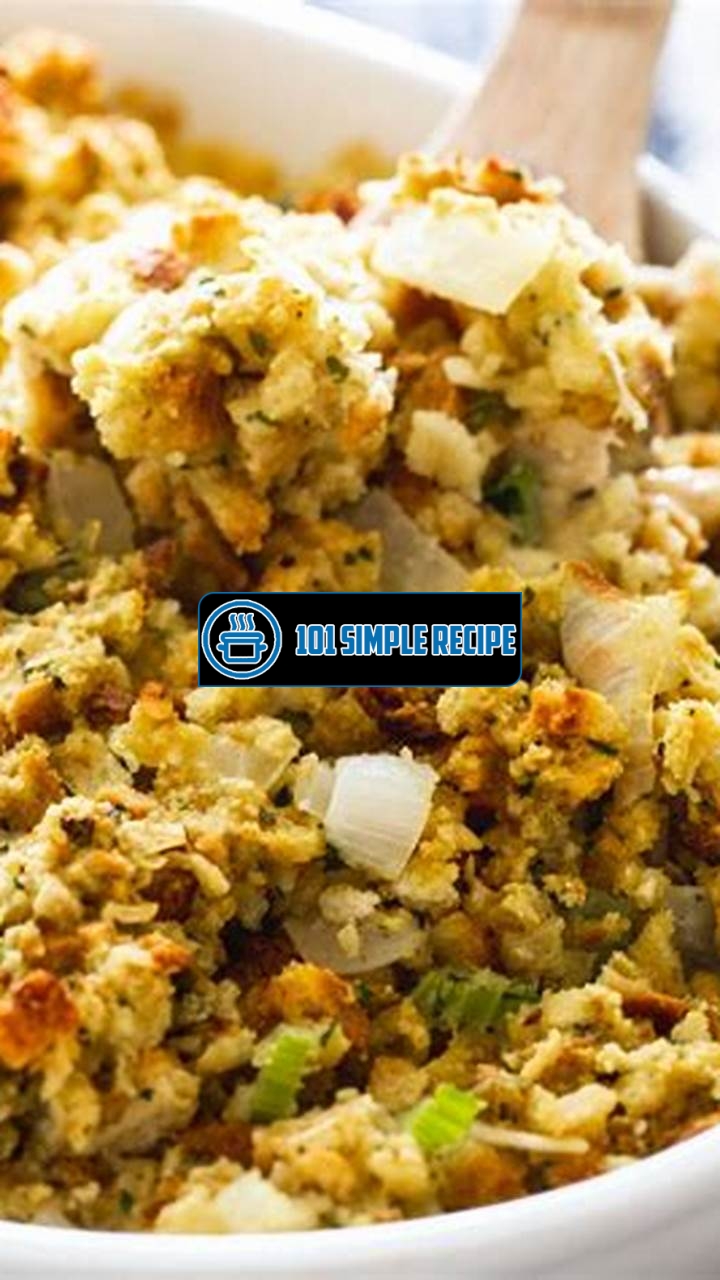Are you craving for a mouthwatering chicken dish with a side of delicious homemade stuffing? Look no further! This article will unveil a recipe that will leave you and your loved ones wanting more. Whether you are hosting a special occasion or simply want to elevate your weeknight dinner, this stuffing recipe is the perfect complement to tender and juicy chicken. Get ready to tantalize your taste buds with the incredible flavors and textures of this homemade stuffing! ️✨

Exploring Homemade Stuffing for Chicken
Discover the art of making flavorful and delicious stuffing for your chicken dishes. Homemade stuffing adds an extra layer of taste and texture to your chicken, making it a mouthwatering dish that will impress your family and friends. In this article, we will delve into the basics of homemade stuffing, the importance of choosing the right ingredients, and the art of proper seasoning. So, let’s uncover the secrets of creating the perfect stuffing to elevate your chicken dishes to a whole new level of deliciousness.
The Basics of Homemade Stuffing
Homemade stuffing is a simple yet essential component of many chicken recipes. It not only adds flavor but also helps to keep the chicken moist and juicy. The basic idea behind stuffing is to create a flavorful mixture that can be stuffed inside the chicken before cooking. This mixture can consist of various ingredients such as bread, vegetables, herbs, and spices. The key to a successful stuffing lies in the right combination of these ingredients.
To start, you’ll need a base ingredient like bread. You can use any type of bread, such as white, whole wheat, or even cornbread, depending on your preference. The bread should be stale or toasted to ensure it absorbs the flavors without becoming too soggy. You can tear the bread into small pieces or cubes to create the desired texture for your stuffing.
Next, you can add an array of vegetables to enhance the flavor and texture of your stuffing. Common choices include onions, celery, carrots, and mushrooms. These vegetables not only provide an extra layer of taste but also add a pleasant crunch to the stuffing. You can sauté them in a bit of oil or butter before incorporating them into the mixture.
In addition to vegetables, herbs and spices play a crucial role in adding depth and complexity to your stuffing. Popular choices include sage, thyme, rosemary, and parsley. These herbs can be either fresh or dried depending on what you have on hand. It’s important to note that herbs should be finely chopped or crushed to release their flavors fully.
Once you have all the ingredients ready, it’s time to combine them in a large mixing bowl. You can season the mixture with salt, pepper, and any other spices that complement the flavors you’re aiming for. Mix everything together until all the ingredients are well incorporated. The stuffing should be moist but not overly wet. If it feels too dry, you can add a bit of chicken broth or melted butter to moisten it.
Choosing the Right Ingredients for Stuffing
When it comes to choosing the right ingredients for your homemade stuffing, there are a few key factors to consider. Firstly, opt for fresh, high-quality ingredients whenever possible. This includes using freshly baked bread, organic vegetables, and aromatic herbs.
Secondly, consider the flavor profile you want to achieve. If you’re aiming for a classic stuffing, using traditional ingredients like onions, celery, and sage is a safe bet. However, don’t be afraid to experiment with different flavors and ingredients to create unique and personalized stuffing.
Lastly, think about the texture you want to achieve. If you prefer a softer stuffing, tear the bread into smaller pieces. For a chunkier texture, leave the bread in larger cubes. Remember that the size and consistency of the ingredients will affect the overall texture of the stuffing.
The Importance of Proper Seasoning
Proper seasoning is the key to taking your homemade stuffing from ordinary to extraordinary. Salt and pepper are the basic seasonings that should be included in every stuffing recipe. However, don’t be afraid to get creative and add additional spices and herbs that complement the flavors of your dish.
The amount of seasoning will depend on your taste preferences, but always start with a conservative amount. You can gradually adjust and taste as you go to ensure the perfect balance. Remember, it’s easier to add more seasoning than to remove excess salt or spice.
In conclusion, mastering the art of making homemade stuffing for chicken is a surefire way to enhance the flavor and texture of your dishes. By understanding the basics of stuffing, choosing the right ingredients, and properly seasoning your mixture, you’ll be able to create mouthwatering chicken dishes that will leave everyone wanting more. So go ahead, explore the world of homemade stuffing, and take your chicken recipes to new heights of deliciousness. ️
Getting Started with Homemade Stuffing
Learn the step-by-step process of preparing homemade stuffing for your chicken recipes.
Prepping the Bread Base
When it comes to making delicious homemade stuffing for chicken, the first step is to prepare the bread base. Start by selecting your preferred type of bread. You can use day-old or stale bread to achieve the best texture and flavor. Cut the bread into small cubes, around half an inch in size.
This is where you can get creative – choose a bread that complements the flavors you want to infuse into your stuffing. Whether it’s a hearty whole wheat bread, a crusty baguette, or a fluffy white loaf, the choice is yours. Make sure to remove the crusts before cubing the bread, as it can become tough and chewy once cooked.
Note: Remember to let the bread cubes dry out for a few hours or overnight before using them in the stuffing. This will ensure that they can absorb the flavors and moisture without becoming mushy.
Adding Aromatic Vegetables for Flavor
The next step in creating a mouthwatering homemade stuffing is to add aromatic vegetables for flavor. Heat a tablespoon of olive oil or butter in a large skillet over medium heat. Add finely chopped onions and garlic, and sauté until they become translucent and fragrant.
To enhance the flavor profile of your stuffing, consider adding other vegetables such as celery, carrots, and mushrooms. Finely chop these vegetables and add them to the skillet along with the onions and garlic. Sauté until they become tender and slightly caramelized.
Pro tip: Adding a small amount of diced bacon or sausage can take the flavor of your stuffing to the next level. Fry the meat until crispy before adding the vegetables, and be sure to drain any excess grease before proceeding.
Enhancing with Herbs and Spices
Now it’s time to enhance your homemade stuffing with a blend of herbs and spices. The combination you choose will depend on your personal preference and the flavor profile you want to achieve. Some classic options include sage, thyme, rosemary, and parsley.
Once the vegetables are cooked, add the herbs and spices to the skillet and stir to incorporate. Allow them to cook for a minute or two to release their flavors. This will infuse your stuffing with aromatic notes that will tantalize your taste buds.
Pro tip: For an extra burst of flavor, you can also add a splash of white wine or chicken stock to the skillet. This will help moisten the ingredients and create a tender and juicy stuffing.
In conclusion, preparing homemade stuffing for your chicken recipes is a straightforward process that requires a few key steps. By prepping a flavorful bread base, incorporating aromatic vegetables, and enhancing with herbs and spices, you can create a mouthwatering stuffing that will elevate your chicken dishes to new heights. So go ahead, unleash your culinary creativity, and enjoy the delicious results!
Creative Variations for Homemade Stuffing
When it comes to homemade stuffing for chicken, there are endless creative variations to explore. These twists on traditional recipes are sure to impress your guests and elevate your chicken dish to new heights. Whether you’re seeking a burst of flavor, experimenting with different types of bread, or incorporating regional and cultural influences, there’s a homemade stuffing variation for everyone.
Adding Fruits and Nuts for a Burst of Flavor
One way to take your homemade stuffing to the next level is by adding fruits and nuts. This not only adds a burst of flavor but also lends a delightful texture to your dish. Consider incorporating dried cranberries, chopped apples, or raisins for a touch of sweetness. If you’re looking to add a nutty crunch, try walnuts, pecans, or almonds. These additions not only enhance the taste of your stuffing but also add visual appeal.
Tip: Don’t be afraid to mix and match different fruits and nuts to create your own unique flavor combination. You can also experiment with different spices, such as cinnamon or nutmeg, to add an extra layer of complexity.
Experimenting with Different Types of Bread
The bread you choose for your stuffing can make a world of difference in terms of taste and texture. While traditional stuffing is often made with plain white bread, don’t be afraid to think outside the box. Consider using sourdough, whole wheat, or cornbread for a more diverse flavor profile. Each type of bread brings its own unique characteristics to the dish, allowing you to customize the stuffing to your preference.
Tip: To add an additional element of flavor, you can also toast the bread cubes before incorporating them into your stuffing mixture. This adds a delightful crunch and enhances the overall taste.
Incorporating Regional and Cultural Influences
If you want to truly wow your guests with your homemade stuffing, consider incorporating regional and cultural influences. Drawing inspiration from different cuisines can bring a whole new dimension to your dish. For example, if you love Mediterranean flavors, you can add olives, feta cheese, and sun-dried tomatoes to your stuffing. If you prefer Asian-inspired dishes, try adding soy sauce, ginger, and sesame oil for an unexpected twist.
Tip: Research traditional stuffing recipes from different cultures for inspiration. You may discover flavor combinations you’ve never thought of before that will truly elevate your chicken dish.
In conclusion, homemade stuffing for chicken doesn’t have to be predictable. By exploring creative variations, adding fruits and nuts, experimenting with different types of bread, and incorporating regional and cultural influences, you can take your stuffing to new heights. Don’t be afraid to get creative in the kitchen and let your taste buds guide you. Your guests will be impressed by the mouthwatering results.
Stuffing Techniques for Different Chicken Dishes
Discover the best stuffing techniques for various chicken dishes, from whole roasted chicken to stuffed chicken breasts.
Stuffing a Whole Roasted Chicken
When it comes to preparing a whole roasted chicken with a delicious homemade stuffing, the key is to ensure that the stuffing is flavorful, moist, and complements the chicken perfectly. One technique is to start by sautéing onions, garlic, and your choice of vegetables in a skillet until they are tender and aromatic. Then, mix in breadcrumbs, herbs, and seasonings to create a stuffing mixture.
Before stuffing the chicken, it’s important to season the bird with salt, pepper, and any desired additional spices. Once the chicken is seasoned, gently loosen the skin to create pockets for the stuffing. Fill these pockets with the prepared stuffing mixture, taking care not to overstuff. Truss the chicken to keep the stuffing securely inside, and roast it in the oven until the chicken is cooked through and the stuffing is golden and crispy.
- Sauté onions, garlic, and vegetables until tender and aromatic.
- Mix in breadcrumbs, herbs, and seasonings to create stuffing mixture.
- Season the chicken with desired spices.
- Gently loosen the chicken skin and fill with stuffing mixture.
- ⛓️ Truss the chicken to hold the stuffing in place.
- Roast the chicken until cooked and stuffing is crispy.
Preparing Stuffed Chicken Breasts
Stuffed chicken breasts are a versatile and flavorful option for a chicken dish. To prepare stuffed chicken breasts with a homemade stuffing, start by choosing your desired stuffing ingredients. This can include a combination of vegetables, cheeses, herbs, and even proteins like bacon or sausage.
Once you have your stuffing ingredients ready, make a pocket in each chicken breast by carefully cutting a slit horizontally through the thickest part of the breast. Be careful not to cut all the way through. Stuff the pockets with the prepared stuffing mixture, ensuring that it is evenly distributed.
Next, season the stuffed chicken breasts with salt, pepper, and any desired herbs or spices. Heat a skillet with some olive oil over medium-high heat and sear the chicken breasts on both sides until they are golden brown. Transfer the breasts to a baking dish and finish cooking them in the oven until they reach an internal temperature of 165°F (74°C).
- Choose desired stuffing ingredients.
- Make a pocket in each chicken breast.
- Stuff the pockets with the prepared stuffing mixture.
- Season the stuffed chicken breasts with salt, pepper, and herbs.
- Sear the chicken breasts in a skillet until golden brown.
- ️ Transfer the chicken breasts to a baking dish and finish cooking in the oven.
Stuffing Techniques for Chicken Roll-Ups
Chicken roll-ups are a tasty and creative way to enjoy homemade stuffing with a unique twist. To make chicken roll-ups, start by pounding the chicken breasts until they are thin and evenly sized. This will make them easier to roll.
Next, prepare a stuffing mixture by combining your choice of ingredients such as vegetables, cheeses, and herbs. Spread a thin layer of the stuffing mixture on each chicken breast, leaving a small border around the edges. Carefully roll up the chicken breasts and secure them with toothpicks or kitchen twine.
Season the chicken roll-ups with salt, pepper, and any desired spices, then place them in a baking dish. Bake in the oven until the chicken is cooked through and the stuffing is hot and bubbly.
- Pound the chicken breasts until thin and even.
- Prepare a stuffing mixture with desired ingredients.
- Spread a thin layer of stuffing on each chicken breast.
- Roll up the chicken breasts and secure with toothpicks or twine.
- Season the chicken roll-ups with salt, pepper, and spices.
- Bake until the chicken is cooked and the stuffing is hot and bubbly.
Troubleshooting Common Stuffing Issues
When it comes to making homemade stuffing for chicken, there are a few common problems that you may encounter. However, with some simple tips and tricks, you can easily troubleshoot these issues and create a mouthwatering stuffing every time. In this article, we will explore three common problems that may arise when making homemade stuffing for chicken recipes and provide you with solutions to overcome them. So, let’s dive in!
Avoiding a Dry Stuffing Texture
One of the most common issues that people face when making stuffing for chicken is ending up with a dry texture. Nobody wants dry and flavorless stuffing, so it’s important to know how to prevent this problem.
To avoid a dry stuffing texture:
- Start by using the right amount of liquid. Be sure to moisten the bread cubes adequately with broth, stock, or even melted butter. This will help to keep the stuffing moist as it bakes.
- Add some vegetables or fruits to your stuffing. Chopped onions, celery, carrots, or even dried cranberries can add moisture and flavor to your stuffing.
- Consider using a combination of different bread types. Mixing soft bread with crusty bread can help to create a more balanced texture and prevent dryness.
- Do not overcook the stuffing. Keep an eye on it while it bakes and remove it from the oven as soon as it is cooked through. Overcooking can result in a dry and unappetizing texture.
By following these tips, you can ensure that your homemade stuffing for chicken turns out moist and delicious every time. No more worries about dry texture!
Preventing a Soggy Stuffing
On the other hand, you may also encounter a problem of ending up with a soggy stuffing. Soggy stuffing can be disappointing, as it lacks the desired texture and can make the whole dish feel unappetizing. Luckily, there are ways to prevent this issue.
To prevent a soggy stuffing:
- Use toasted or stale bread cubes. Fresh bread tends to absorb more liquid, which can lead to a soggy texture. Toasting the bread beforehand or using stale bread can help to prevent excessive moisture absorption.
- Avoid over-stuffing the chicken. If you pack too much stuffing inside the chicken, it can release excess moisture during the cooking process and make it soggy. Leave some room for the stuffing to expand.
- Bake the stuffing separately. Instead of stuffing the chicken cavity, you can bake the stuffing in a separate dish. This will allow it to cook evenly and prevent it from becoming soggy due to the chicken’s juices.
By following these tips, you can ensure that your homemade stuffing for chicken maintains a perfect texture without being overly soggy. Enjoy a delightful and well-textured stuffing with your chicken!
Dealing with Stuffing that Falls Apart
Lastly, another common issue that you may face is stuffing that falls apart. It can be disheartening to see your carefully prepared stuffing crumble and lose its shape. However, there are strategies to overcome this problem.
To deal with stuffing that falls apart:
- Make sure your bread cubes are of the right size. If they are too large, the stuffing may not hold together properly. Ensure that the bread cubes are uniform in size.
- Consider using eggs as a binder. Beating an egg or two and adding it to the stuffing mixture can help to bind the ingredients together and prevent crumbling.
- Add some moisture. If your stuffing mixture appears dry, it may crumble easily. Adjust the moisture level by adding a bit more broth or melted butter until the mixture holds together better.
- Let the stuffing rest before serving. Allowing the stuffing to cool and set for a few minutes after baking can help it hold its shape better when serving.
By applying these techniques, you can ensure that your homemade stuffing for chicken stays intact and presents beautifully on the plate. Say goodbye to crumbly stuffing!
So, the next time you encounter any of these common stuffing issues when making homemade stuffing for chicken, don’t fret. With the tips and solutions provided, you’ll be able to troubleshoot and overcome these problems easily, resulting in a delicious and mouthwatering stuffing that perfectly complements your chicken dish. Happy cooking!
Frequently Asked Questions
Here are some commonly asked questions about homemade stuffing for chicken:
| No. | Questions | Answers |
|---|---|---|
| 1. | How do I make homemade stuffing for chicken? | To make homemade stuffing for chicken, you will need breadcrumbs, onions, celery, herbs, and chicken broth. Sauté the onions and celery, then mix them with the breadcrumbs and herbs. Add chicken broth to moisten the mixture. Stuff the chicken with the stuffing and bake until cooked through. |
| 2. | Can I use store-bought stuffing for chicken? | Yes, you can use store-bought stuffing for chicken if you prefer. Follow the instructions on the packaging to prepare the stuffing mixture and stuff it into the chicken before baking. |
| 3. | How long does it take to cook stuffed chicken? | The cooking time for stuffed chicken depends on the size of the chicken and the stuffing. Generally, it takes about 25-30 minutes per pound of chicken at 350°F. Use a meat thermometer to ensure the internal temperature of the chicken reaches 165°F. |
| 4. | What herbs can I use in homemade stuffing for chicken? | You can use a variety of herbs in homemade stuffing for chicken, such as sage, thyme, rosemary, or parsley. Experiment with different combinations to find your favorite flavors. |
| 5. | Can I make stuffing for chicken ahead of time? | Yes, you can make the stuffing for chicken ahead of time. Prepare the stuffing mixture and store it in an airtight container in the refrigerator. Stuff the chicken just before baking. |
| 6. | What can I serve with stuffed chicken? | Stuffed chicken pairs well with a variety of side dishes, such as roasted vegetables, mashed potatoes, or a fresh salad. Choose your favorite accompaniments to create a complete and delicious meal. |
Thanks for Reading!
We hope you enjoyed learning how to make homemade stuffing for chicken. It’s a versatile and tasty dish that will impress your family and friends. Don’t forget to visit again later for more delicious recipes and cooking tips. Happy cooking!
Jump to Recipe
Homemade Stuffing for Chicken

Learn how to make delicious homemade stuffing for chicken with this easy recipe. It’s the perfect accompaniment to a roasted chicken dinner.
- 2 cups breadcrumbs
- 1 onion (finely chopped)
- 2 stalks celery (finely chopped)
- 1 teaspoon dried sage
- 1 teaspoon dried thyme
- 1/2 teaspoon salt
- 1/4 teaspoon pepper
- 1/2 cup chicken broth
- Preheat the oven to 350°F.
- In a skillet, sauté the onions and celery until softened.
- In a large bowl, combine the breadcrumbs, sage, thyme, salt, and pepper.
- Add the sautéed onions and celery to the breadcrumb mixture.
- Slowly pour in the chicken broth, stirring to moisten the stuffing.
- Stuff the chicken cavity with the stuffing mixture.
- Place the stuffed chicken in a baking dish and bake for about 1 hour, or until the internal temperature reaches 165°F.
- Remove the chicken from the oven and let it rest for 10 minutes before carving.
- Serve the stuffed chicken with your favorite side dishes and enjoy!






